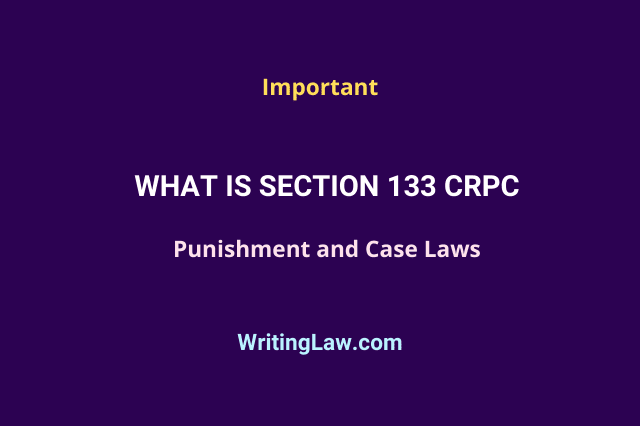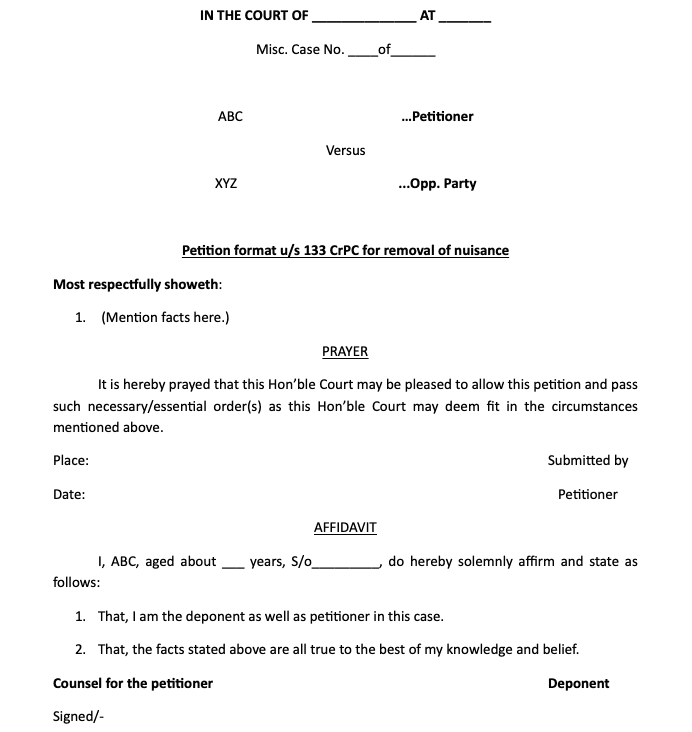
There is a provision in the Code of Criminal Procedure under section 133 to remove the nuisance. The author analyses the law and focuses on the certain facilities available to the complainant for the removal of the nuisance.
First, what is a nuisance under CrPC? Nuisance is someone or something that irritates, causes inconveniences or makes life more difficult.
Types of Nuisance in CrPC
There are two types of nuisance under the Criminal Procedure Code. They are Public Nuisance and Private Nuisance.
Public Nuisance vs Private Nuisance
Under section 268 of the IPC, public nuisance has been defined. It is an offence against the public, either by doing anything that expresses frustration or by refusing or omitting to do anything necessary for the common benefit. It’s an act or omission that causes the public or persons generally who reside or occupy a common area to be harmed or upset.
On the other hand, private nuisance annoys or impacts a few people compared to the general public.
Section 133 CrPC Explained
Section 133 CrPC establishes a rudimentary method for the disposal of public nuisances in emergencies. According to this provision, anytime a District Magistrate, a Sub-Divisional Magistrate, or any other Executive Magistrate specially empowered in this regard by the State Government receives a police officer’s report or other information and takes such evidence (if any) as he deems appropriate:
A. That any unlawful impediment or nuisance be removed from any public area, including any road, river, or channel that is or may be utilised legitimately by the public.
B. That the conduct of any trade or occupation, or the keeping of any goods or merchandise, is harmful to the community’s health or physical comfort, and that, as a result, such trade or occupation, or such goods or merchandise, should be outlawed or restricted, or their keeping regulated.
C. That the construction of any structure, or the disposal of any substance, that is likely to cause configuration or explosion be avoided or stopped.
D. That any building, tent, structure or any of the trees is subject to such an extent that the building, tent or structure, or support, or removal or support of such a tree is likely to be lost, causing injury to individuals residing or carrying on business in or outside the neighbourhood and as such.
E. That any tank, well, or excavation near any such way or public area is fenced in such a way as to prevent public risk.
F. Any harmful animal should be killed, confined, or otherwise dealt with.
Such Magistrate shall, within a period to be determined by order, make a conditional order requiring the person who causes such obstruction or nuisance; or who carries on or holds such good or goods; or holds, possesses or controls such buildings, tents, structures, substances, tanks, wells or excavations; or possesses or owns such animals and tree:
I. To remove, desist (stop doing/discontinue), prevent, remove, repair, fence, destroy such public nuisance or obstruction or animal as the case may be.
II. Or, if the accused person objects to appear before the Magistrate or any Executive Magistrate subordinate to him at a time and place fixed by the order, and show cause why the order should not be made absolute, in the manner hereunder provided.
Note: No order made by a Magistrate in accordance with this section may be challenged in a civil court.
Punishment Under Section 133 CrPC
The punishment for the conduct of offences concerning public nuisance is provided under sections 268 to 294A of the Indian Penal Code.
In cases that are not provided under section 290 of the Indian Penal Code, public nuisance is punishable. These are fined offences that can extend up to Rs. 200. The remedy in the case of private nuisance is a civil suit.
Section 133 CrPC Case Laws
Here are some of the important case laws and judgments on section 133 CrPC.
1. Ajeet Mehta vs the State of Rajasthan
Fodder was determined to constitute contamination of the atmosphere and, thus, a public nuisance on a particular plot in a residential colony. The order to remove this nuisance was held valid, and the respondents were told to perform no food business on the land.
2. Corbet vs Sonaula
Parking buses on private lands, obstructing the private route, a private road, and Khatal constructed on private property near a public road which creates disadvantages and effects on sanitation, are not covered by section 133 CrPC. (Because these are private properties)
3. Nagarjuna Paper Mills vs SDM & Ors
It was noticed by the High Court of Andhra Pradesh that the power to close a factory creating pollution had been removed by the Water Act, 1974, from the power of the Sub-Divisional Magistrate.
4. Ram Avatar vs the State of UP
Auction of the vegetables in the town’s private house and the parking of vegetable carts on the public roads outside the building must necessarily cause some discomfort to the public and also to the people in the town. But it doesn’t justify action under section 133 of CrPC.
5. Nurjan, 1900 PR2
Prostitutes who continue their business in order and silence can’t be interfered with until they become an annoyance by asking passers-by.
Section 133 CrPC Sample Petition Format
IN THE COURT OF ______________ AT _______
Misc. Case No. ____of______
ABC …Petitioner
Versus
XYZ …Opp. Party
Petition format u/s 133 CrPC for removal of the nuisance.
Most respectfully showeth:
- (Mention facts here.)
PRAYER
It is hereby prayed that this Hon’ble Court may be pleased to allow this petition and pass such necessary/essential order(s) as this Hon’ble Court may deem fit in the circumstances mentioned above.
Place: Submitted by
Date: Petitioner
AFFIDAVIT
I, ABC, aged about ___ years, S/o_________, do hereby solemnly affirm and state as follows:
- That, I am the deponent as well as petitioner in this case.
- That, the facts stated above are all true to the best of my knowledge and belief.
Counsel for the petitioner. Deponent
Signed/-
Here is the above information in this sample image.

- 10 Types or Kinds of Jurisdiction of Indian Courts - 13th April 2022
- Malicious Charge of Offence Under Section 211 of the Indian Penal Code - 17th March 2022
- About Supreme Court of India – Collegium, Powers, Judges - 7th February 2022







